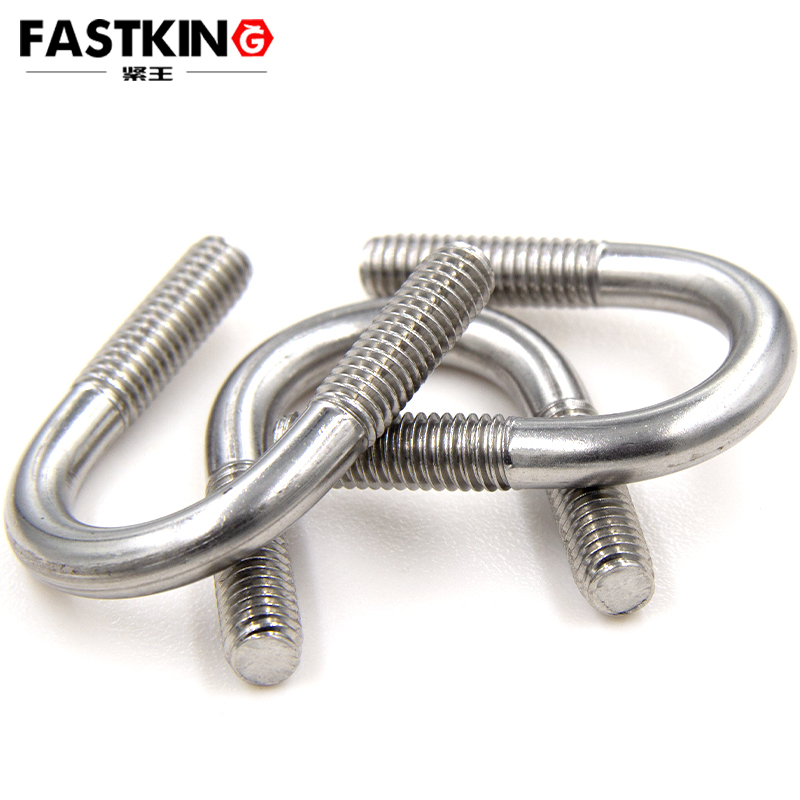The Use and Applications of U-Bolts
Introduction
U-bolts, also known as horseshoe bolts or U-shaped clamps, are widely used fasteners in industrial and construction applications. Their unique U-shaped design provides reliable support and secure fastening for various objects. This article will provide a detailed overview of the structure, usage methods, and applications of U-bolts.
Structure of U-Bolts
U-bolts are typically made from high-strength steel and consist of the following main components:
1. U-Shaped Bend: Designed to encircle and secure pipes, cylindrical objects, or other components.
2. Threaded Rods: Located at the ends of the U-shaped bend, these are used for installing nuts and washers.
3. Nuts and Washers: Used to tighten and secure the U-bolt, ensuring it is firmly attached to the object.

How to Use U-Bolts
1. Selecting the Right U-Bolt
Before using a U-bolt, choose one that matches the diameter and strength requirements of the object. Common sizes include M6, M8, M10, and M12.
2. Installing the U-Bolt
Place the U-shaped bend of the U-bolt around the object to be secured, ensuring that the threaded rods pass through the mounting holes or supports.
- Install washers and nuts on the threaded rods, positioning the washers between the nuts and the object to enhance clamping effectiveness and protect the surface.
3. Tightening the Nuts
Use a wrench or power tool to rotate the nuts clockwise, applying steady pressure until the U-bolt is securely fastened to the object.
Ensure that the nuts are tightened evenly to avoid uneven clamping, which can compromise the security and safety of the fastening.

4. Checking the Fastening Effect
After tightening, inspect the U-bolt to ensure it is securely attached to the object without any looseness or slippage.
Applications of U-Bolts
1. Construction Industry
In construction, U-bolts are commonly used to secure steel structures, pipes, and cable trays. Their high clamping strength and material durability make them capable of withstanding the high loads and vibrations in building structures.
2. Bridge Engineering
In bridge construction, U-bolts are used to secure guardrails, cables, and pipes. Their corrosion resistance and high strength make them suitable for the harsh conditions encountered in bridge environments.
3. Pipeline Installation
In pipeline systems, U-bolts are used to secure water, gas, and oil pipes. The U-shaped design allows for a firm grip around the pipes, ensuring they remain stable during installation and operation.
4. Automotive Manufacturing
In the automotive industry, U-bolts are used to secure chassis components, exhaust systems, and suspension systems. Their high strength and corrosion resistance make them ideal for withstanding the high demands of automotive applications.
5. Mechanical Equipment
In machinery, U-bolts are used to secure motors, pumps, and fans. Their high clamping strength and material durability make them capable of withstanding the high loads and vibrations in mechanical equipment.

Precautions for Using U-Bolts
1. Select the Right Size: Choose a U-bolt that matches the diameter and strength requirements of the object to avoid issues with bolt length or strength.
2. Avoid Over-Tightening: When tightening nuts, avoid excessive force to prevent damage to the bolt or the object.
3. Regular Inspection: Periodically check the fastening effect of the U-bolts and replace any loose or damaged ones to ensure the safety and stability of the structure.
4. Storage Conditions: Store U-bolts in a dry, corrosion-free environment to prevent rust and damage.
Conclusion
U-bolts are versatile and efficient fasteners, widely used in construction, bridge engineering, pipeline installation, automotive manufacturing, and mechanical equipment. Proper selection, installation, and maintenance of U-bolts can significantly enhance work efficiency and operational safety. This article aims to provide readers with a comprehensive understanding of U-bolts and how to use them effectively.
